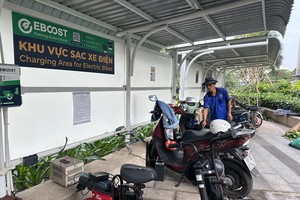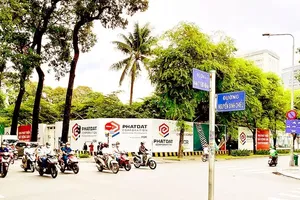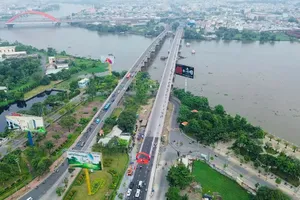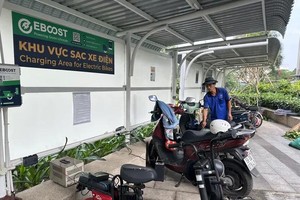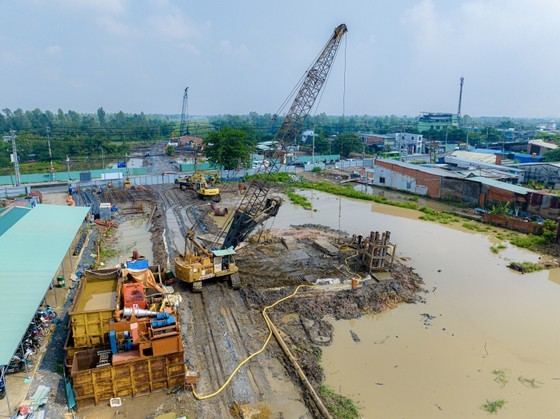 |
The Ring Road 3 project is underway |
In the report reviewing the disbursement of compensation capital in 2023, a representative from the Department of Natural Resources and Environment of Ho Chi Minh City wrote that the significant gap in the initial cost calculation and the implementation of compensation, clearance, and resettlement in public investment projects has led to a surplus and a shortage, which has more or less affected the progress of these projects.
For instance, according to the original decision on the initial estimate of the city Ring Road 3 Project at the end of 2022, city authorities planned to spend VND18,900 billion (US$772,362,531) for compensation but so far it needs less than VND11,700 billion, a decrease of more than VND7,200 billion.
According to the Department of Natural Resources and Environment of Ho Chi Minh City, when relevant agencies submitted the pre-feasibility study report of the Ring Road 3 project in Ho Chi Minh City, four districts including Thu Duc City, Cu Chi, Hoc Mon, Binh Chanh districts realized the capital needed to be allocated fully, avoiding funding shortages that lead to having to report to the National Assembly to adjust the total investment. The compensation unit price is also estimated according to the highest level in the land price adjustment coefficient framework.
For example, Binh Chanh district has adjusted the land price coefficient framework for residential land ranges from 6-22 and agricultural land from 15-38, while the People's Committee of Binh Chanh district chose the coefficient 22 for residential land and the coefficient 38 for agricultural land while Thu Duc City authority decided that agricultural land is only calculated based on the unit price of land for perennial crops without classifying land for annual and perennial crops.
Similarly, for works, architectural objects and support for training, career change are calculated at the highest level. In addition, lands directly managed by the state according to regulations are not compensated, but when calculating, this area is also included as in the case of compensation.
Therefore, the estimated compensation cost is very high, up to more than VND25,600 billion. At the time of approval of the compensation project, the compensation unit price is updated in the feasibility study report. In December 2022, the Ho Chi Minh City People's Committee approved the compensation project with a total cost of VND18,906 billion.
According to the Department of Natural Resources and Environment, at this time, people have not provided complete legal documents, so the determination of compensation costs is still higher than reality. When localities legally review documents provided by people and subtract land funds directly managed by the state, capital resources decrease significantly. Specifically, Thu Duc City needs VND6,225 billion, Cu Chi district needs VND1,718 billion, Hoc Mon district needs VND1,614 billion and Binh Chanh district needs VND1,687 billion.
In addition, the total cost of relocation of technical infrastructure, construction of resettlement area infrastructure and other costs is VND453 billion. Thus, the total compensation funding needs of the four districts only reach VND 11,688 billion, a decrease of VND7,206 billion compared to the decision at the end of 2022, and a decrease of more than 50 percent compared to the pre-feasibility study estimate.
The initial estimated capital is surplus compared to reality when responsible agencies calculate compensation and clearance work in projects as the Ho Chi Minh City Ring Road 3 is not the only project with excess capital.
According to a survey by the Department of Natural Resources and Environment of Ho Chi Minh City, the list of projects with excess capital also includes Duong Quang Ham Street in Go Vap District which reported a reduction in investment of VND225 billion or the D8 road - a section from Bui Minh Truc Street to Ta Quang Buu Street in District 8 also witnessed a reduction of VND50 billion. Moreover, the projects Dam Sen Ring Road in District 11, Ong Nhieu Bridge in Thu Duc City and Tang Long Bridge in Thu Duc City decreased by VND40 billion, VND195 billion and VND147 billion due to surplus estimates.
On the contrary, several projects in Thu Duc City such as My Thuy intersection, La Xuan Oai Street - a section from Lo Lu Street to Nguyen Duy Trinh Street have seen an increase in compensation capital by VND366 billion and VND260 billion. In order to fully calculate compensation, support, and resettlement costs, avoiding some projects with capital oversupply whereas other projects with capital shortage, the Ho Chi Minh City Department of Natural Resources and Environment has proposed a number of solutions.
Specifically, according to the Department, the project's pre-feasibility study process needs to fully evaluate and determine the exact project scope and boundaries. The consulting unit preparing the pre-feasibility study report needs to coordinate with district administrations and Thu Duc City government to refer to the unit price of the ongoing project, similar location with the most recent price approval, and calculate more price inflation factor to estimate costs. The survey of the current status of the project boundary needs to be compared with the cadastral map according to the VN 2000 coordinate system to determine cases of house construction before July 2004 as the initial basis for compensation or support.
Regarding lands directly managed by state agencies, it is necessary to review carefully to reduce the estimated compensation costs. After the investment policy is approved, it is necessary to speed up the project process to avoid an increase in land prices that will increase compensation costs. In addition, local authorities need to mobilize people to agree on measuring, counting and providing legal documents before issuing land recovery notices so that the affected area can be accurately determined as a basis for calculating compensation costs before project approval.






